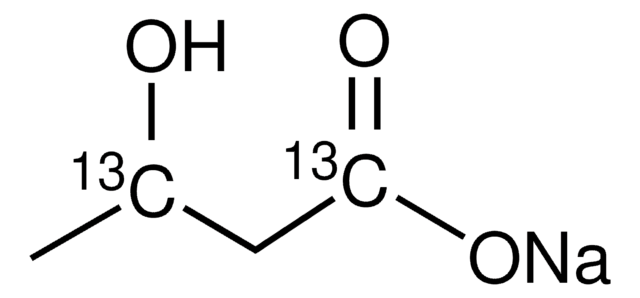Products may be shipped at a different temperature than the recommended long-term storage temperature. If the product quality is sensitive to short-term exposure to conditions other than the recommended long-term storage, it will be shipped on wet or dry-ice. If the product quality is NOT affected by short-term exposure to conditions other than the recommended long-term storage, it will be shipped at ambient temperature. As shipping routes are configured for minimum transit times, shipping at ambient temperature helps control shipping costs for our customers. For more information, please refer to the Storage and Transport Conditions document: https://www.sigmaaldrich.com/deepweb/assets/sigmaaldrich/marketing/global/documents/316/622/storage-transport-conditions-mk.pdf
166898
3-Hydroxybutyric acid
95%
Synonyme(s) :
(±)-3-Hydroxybutanoic acid, DL-β-Hydroxybutyric acid
Sélectionner une taille de conditionnement
Sélectionner une taille de conditionnement
About This Item
Produits recommandés
Niveau de qualité
Essai
95%
Forme
liquid
Indice de réfraction
n20/D 1.443 (lit.)
pb
118-120 °C/2 mmHg (lit.)
Solubilité
ethanol: soluble 50 mg/mL, clear
Densité
1.126 g/mL at 25 °C
1.126 g/mL at 25 °C (lit.)
Groupe fonctionnel
carboxylic acid
hydroxyl
Température de stockage
2-8°C
Chaîne SMILES
CC(O)CC(O)=O
CC(O)CC(O)=O
InChI
1S/C4H8O3/c1-3(5)2-4(6)7/h3,5H,2H2,1H3,(H,6,7)
Clé InChI
WHBMMWSBFZVSSR-UHFFFAOYSA-N
WHBMMWSBFZVSSR-UHFFFAOYSA-N
Vous recherchez des produits similaires ? Visite Guide de comparaison des produits
Catégories apparentées
Description générale
Application
Mention d'avertissement
Danger
Mentions de danger
Classification des risques
Eye Dam. 1 - Skin Corr. 1B
Code de la classe de stockage
8A - Combustible corrosive hazardous materials
Classe de danger pour l'eau (WGK)
WGK 3
Point d'éclair (°F)
233.6 °F - closed cup
Point d'éclair (°C)
112 °C - closed cup
Équipement de protection individuelle
Eyeshields, Gloves, type ABEK (EN14387) respirator filter
Faites votre choix parmi les versions les plus récentes :
Déjà en possession de ce produit ?
Retrouvez la documentation relative aux produits que vous avez récemment achetés dans la Bibliothèque de documents.
Les clients ont également consulté
Chromatograms
suitable for GC-
How is shipping temperature determined? And how is it related to the product storage temperature?
1 answer-
Helpful?
-
-
How can I determine the shelf life / expiration / retest date of this product?
1 answer-
If this product has an expiration or retest date, it will be shown on the Certificate of Analysis (COA, CofA). If there is no retest or expiration date listed on the product's COA, we do not have suitable stability data to determine a shelf life. For these products, the only date on the COA will be the release date; a retest, expiration, or use-by-date will not be displayed.
For all products, we recommend handling per defined conditions as printed in our product literature and website product descriptions. We recommend that products should be routinely inspected by customers to ensure they perform as expected.
For products without retest or expiration dates, our standard warranty of 1 year from the date of shipment is applicable.
For more information, please refer to the Product Dating Information document: https://www.sigmaaldrich.com/deepweb/assets/sigmaaldrich/marketing/global/documents/449/386/product-dating-information-mk.pdfHelpful?
-
-
3-ヒドロキシ酪酸は液体とのことですが,濃度はどれくらいになるのでしょうか?
1 answer-
This product is a neat or pure liquid and has not been diluted. The density of this material is 1.126 g/mL at 25 °C with a molecular weight of 104.1 daltons. The minimum purity of this product is 95%. The molarity of this product may range from 10.26 M at 95% to 10.8 M at 100%. Please refer to product Certificate of Analysis for the lot specific purity.
Helpful?
-
-
What's the solubility in paraffin oil?
1 answer-
Unfortunately, solubility information for Product 166898 in paraffin oil is unavailable. However, it is soluble in ethanol at 50 mg/mL.
Helpful?
-
Active Filters
Notre équipe de scientifiques dispose d'une expérience dans tous les secteurs de la recherche, notamment en sciences de la vie, science des matériaux, synthèse chimique, chromatographie, analyse et dans de nombreux autres domaines..
Contacter notre Service technique










![Poly[(R)-3-hydroxybutyric acid] natural origin](/deepweb/assets/sigmaaldrich/product/structures/129/476/7d1c924b-f644-4889-a2d6-d7a923ce382c/640/7d1c924b-f644-4889-a2d6-d7a923ce382c.png)


